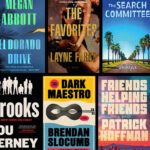As someone who has spent their life in motorsports from the day I left school until I took the plunge and switched careers in 2019, I was constantly being asked when I would write a book about racing. A year ago, I finally decided to include a motor racing theme in book fifteen of my AJ Bailey Adventure series. The result? Polarized. Readers either loved the insight into the sport, or drearily trudged through, or simply skipped the racing parts.
So, what had I done wrong?
According to one reader: ‘I’d rather stare at a rusty bucket of bolts in the corner of my garage than watch auto racing.’ Okay, I don’t think I was ever going to hook this fellow with anything motor racing related, but I also received other notes and reviews about the level of detail I’d delved into. In both directions; critical and praising.
The book, Lighthouse Point, was a passion project for me and a nod to my late father who’d spent his life in racing and shoved my backside in a go-kart when I was ten years old. My goal with the racing storyline, which was set in the glamourous and incredibly dangerous era of Grand Prix racing in 1970, was to put the reader in the driver’s seat and have them experience the tactile and exhilarating feel of being behind the wheel. For those interested in cars, excited to learn, or drawn into following the story of the fictional fledgling independent team I placed amongst the actual racers and storied names of the time, they loved the sensation of being immersed in the action.
The balancing act of choosing a level of detail wasn’t new to me. The series is based around a female dive boat operator in the Cayman Islands who seems to always find herself mixed up in trouble of some kind. Most of the books are written in dual timeline, following a storyline in history which ultimately converges and resolves in AJ Bailey’s present day world. Scuba diving itself, even basic recreational diving, has technical details and knowledge which if ignored can seriously injure you or kill you. My series has become very popular in the diving community, so making sure these details are both correct, and not ignored, is critical.
But a larger percentage of my readers have never put a regulator in their mouths, and never had to worry about nitrogen narcosis, rapidly expanding bubbles in their blood system, or no-decompression limits. Yup, how do you slide info like that into a story without generating a page-skipper instead of a page-turner? Tricky, right? Now write a lengthy series where these terms and situations will crop up repeatedly, but you can’t guarantee your new readers start with book one. Many will join the series in book sixteen then go back to the beginning if they enjoy the latest release. So, you can’t throw in a term like DCS (decompression sickness) and expect them to know what you’re talking about.
The solution I’ve found after clumsily learning through the early novels, is to make sure a technical detail is critical to the story, or necessary for the situation, then find the briefest way possible to describe it. I’m not going to blather on about the intricacies of nitrogen narcosis – a drug-like euphoria caused by a large presence of nitrogen molecules in your system when diving deeper – when AJ is guiding her customers on a shallow reef.
The next challenge is to drop the information into the narrative or conversation without sounding like a manual or textbook. Having AJ verbally warn another diver about the dangers before they get in the water is a useful trick. Now you’re setting the reader up to expect and feel the tension as the errant diver becomes disorientated in the wreck at 130 feet down. Timed right, the reader is yelling at the diver not to go farther inside the shipwreck. Or a shed full of chainsaws.
Breaking up the information is also a useful technique. Similar to how I try to drip-feed my protagonist’s description over the early chapters.
‘AJ’s shoulder length blond and purple highlighted hair soon dried with the warm tropical air rushing over the bridge as she steered the dive boat towards shore.’
A little later in the chapter, I may have her slip on a long-sleeved sunshirt to protect her colourfully tattooed arms from the sun. The same system can work for technical details which will be important to the story later on. I might describe them filling the tanks with nitrox gas instead of air before leaving the dock, a mix with a higher percentage of oxygen. Now I can reference nitrox and have AJ tell someone:
‘We’re diving nitrox which will extend our ability to stay deeper without going into deco.’
I still have to tell the reader what ‘deco’ means, but at least I don’t have to also stack an info dump on nitrox at the same time.
In diving there is specialised equipment involved which presents a similar challenge. Your regular readers already know what a BCD is, but the new prospective fan who grabbed your latest release may has no idea.
‘AJ donned her buoyancy control device, or BCD as they’re commonly called, the vest-like piece of equipment holding her tank.’
Everyone has seen a picture of a scuba diver wearing some sort of jacket with a tank on their back, so now they know it’s a BCD and we can move on to dropping into the turquoise gin-clear water of the Caribbean Sea. A short enough sentence that your regular readers aren’t shouting at their ereader about how they already know this, but enough information to keep from losing the newbie to your stories and scuba diving.
A glossary has been a tool used by many in the past, but I prefer not to pause the story to have the reader go look something up. You can hyperlink in an ebook, but it’s still a break in the flow, especially when the information is required during an action sequence or tense moment.
Keep it brief, break it up, and make sure it’s critical to the story or required for authenticity. Which leads into my final point.
Get it right.
Someone who knows what they’re talking about, whether it’s flying a plane, handling a firearm, or scuba diving to the depths, will call you out if your description is inaccurate. Almost every film ever made about motor racing is unwatchable for anyone who has competitively raced cars. They’re filled with technical flaws, often to the point of being ridiculous. No driver ever goes down the long straight at three-quarter throttle, waiting for their rival to pull alongside so they can ‘mash the gas’ to the floor to surge ahead again. Their foot was already on the stop from the first moment traction off the previous corner allowed until the latest braking point for the next corner. Get it right, or you’ll aggravate and lose knowledgeable readers.
So, did I include too much nuance and fine detail in Lighthouse Point? Certainly, for some I did, but that was a decision I made going in. As I mentioned, it was a passion project, so I accepted the hits to tell a story and share a love of mine which had dominated my family’s life. I thought of my dad while I wrote every racing scene, and it was my gift to him. I’m proud of the book knowing he would have loved it.
But I didn’t hit the ‘please everyone’ balance between detail, technical jargon, and story to make the masses happy. The next book released in the series is titled Spitfire Storm, where the historical timeline follows a female ATA pilot in WWII England. In this story it was easier for me to temper the technical detail as I’m not a pilot and relied heavily on research and advice to accurately portray the aerial scenes. Spitfire Storm has been the most popular release in the series so far, so in hindsight, the valuable lesson I learnt from Lighthouse Point helped me fine tune the balance for future books.
***


















